Correlation of Rate of TEC Index and Spread F over European Ionosondes
Abstract
1. Introduction
2. Instruments and Methods
2.1. GPS IGS TEC Map Products
2.2. Digisondes over Europe
3. Results and Discussions
3.1. Case Study: 1 (2–3 July 2011)
3.2. Case Study: 2 (3–4 April 2011)
3.3. Case Study: 3 (5–6 August 2011)
3.4. Diurnal Variation
3.5. Seasonal Variation
4. Summary
- RSF has been recorded in the ionogram for all the ROTI (>0.15 TECU/min) occurrences observed in 2011. This behaviour was seen independently of geomagnetic activity for both low and upper mid-latitude Digisonde stations.
- MSTIDs, which may develop as a result of induced gravity waves or polarisation electric fields [37], are driving most ROTI enhancements also related to RSF.
- During a geomagnetic storm, the spatial extent of irregularities increases.
- The diurnal variation in the mid-latitude ionospheric irregularity occurrences is a latitude-dependent [30,31,32], nighttime phenomenon. The maximum extent of this occurrence was noted around 55° N (time zone = UT + 01:00) latitude from 18:00 to 05:30 UT, 18:00 to 05:00 UT around 50° N (time zone = UT for Fairford and Chilton; UT + 01:00 for Dourbes and Pruhonice) and over the lower mid-latitude Digisonde (time zone = UT + 01:00 for Roquetes and Rome; UT + 02:00 for Athens) stations from 19:00 to 04:30 UT.
Author Contributions
Funding
Institutional Review Board Statement
Informed Consent Statement
Data Availability Statement
Acknowledgments
Conflicts of Interest
References
- Chapman, S. The electrical conductivity of the ionosphere: A review. Il Nuovo C. (1955–1965) 1956, 4 (Suppl. S4), 1385–1412. [Google Scholar] [CrossRef]
- Schunk, R.; Nagy, A. Ionospheres: Physics, Plasma Physics, and Chemistry; Cambridge University Press: Cambridge, UK, 2009. [Google Scholar]
- McNamara, L.F. Prediction of total electron content using the International Reference Ionosphere. Adv. Space Res. 1984, 4, 25–50. [Google Scholar] [CrossRef]
- Pi, X.; Mannucci, A.J.; Lindqwister, U.J.; Ho, C.M. Monitoring of global ionospheric irregularities using the worldwide GPS network. Geophys. Res. Lett. 1997, 24, 2283–2286. [Google Scholar] [CrossRef]
- Basu, S.; Groves, K.M.; Quinn, J.M.; Doherty, P. A comparison of TEC fluctuations and scintillations at Ascension Island. J. Atmos. Sol.-Terr. Phys. 1999, 61, 1219–1226. [Google Scholar] [CrossRef]
- Kotulak, K.; Zakharenkova, I.; Krankowski, A.; Cherniak, I.; Wang, N.; Fron, A. Climatology characteristics of ionospheric irregularities described with GNSS ROTI. Remote Sens. 2020, 12, 2634. [Google Scholar] [CrossRef]
- Cherniak, I.; Zakharenkova, I.; Krankowski, A. Approaches for modelling ionosphere irregularities based on the TEC rate index. Earth Planets Space 2014, 66, 165. [Google Scholar] [CrossRef]
- Cherniak, I.; Krankowski, A.; Zakharenkova, I. ROTI Maps: A new IGS ionospheric product characterizing the ionospheric irregularities occurrence. GPS Solut. 2018, 22, 69. [Google Scholar] [CrossRef]
- Tiwari, R.; Strangeways, H.J.; Tiwari, S.; Ahmed, A. Investigation of ionospheric irregularities and scintillation using TEC at high latitude. Adv. Space Res. 2013, 52, 1111–1124. [Google Scholar] [CrossRef]
- Kintner, P.M., Jr.; Coster, A.J.; Fuller-Rowell, T.; Mannucci, A.J.; Mendillo, M.; Heelis, R. (Eds.) Midlatitude Ionospheric Dynamics and Disturbances; John Wiley & Sons: Hoboken, NJ, USA, 2013; Volume 181. [Google Scholar]
- Vadakke Veettil, S.; Haralambous, H.; Aquino, M. Observations of quiet-time moderate midlatitude L-band scintillation in association with plasma bubbles. GPS Solut. 2017, 21, 1113–1124. [Google Scholar] [CrossRef]
- Berkner, L.V.; Wells, H.W. F-region ionosphere-investigations at low latitudes. Terr. Magn. Atmos. Electr. 1934, 39, 215–230. [Google Scholar] [CrossRef]
- Bowman, G.G. Ionospheric frequency spread and its relationship with range spread in mid-latitude regions. J. Geophys. Res. Space Phys. 1991, 96, 9745–9753. [Google Scholar] [CrossRef]
- Bowman, G.G. Short-term delays (hours) of ionospheric spread F occurrence at a range of latitudes, following geomagnetic activity. J. Geophys. Res. Space Phys. 1998, 103, 11627–11634. [Google Scholar] [CrossRef]
- Wang, Z.; Shi, J.K.; Torkar, K.; Wang, G.J.; Wang, X. Correlation between ionospheric strong range spread F and scintillations observed in Vanimo station. J. Geophys. Res. Space Phys. 2014, 119, 8578–8585. [Google Scholar] [CrossRef]
- Kelley, M.C.; Fukao, S. Turbulent upwelling of the mid-latitude ionosphere: 2. Theoretical framework. J. Geophys. Res. Space Phys. 1991, 96, 3747–3753. [Google Scholar] [CrossRef]
- Perkins, F. Spread F and ionospheric currents. J. Geophys. Res. 1973, 78, 218–226. [Google Scholar] [CrossRef]
- Kelley, M.C.; Makela, J.J.; Ledvina, B.M.; Kintner, P.M. Observations of equatorial spread-F from Haleakala, Hawaii. Geophys. Res. Lett. 2002, 29, 64-1–64-4. [Google Scholar] [CrossRef]
- Huang, C.S.; Miller, C.A.; Kelley, M.C. Basic properties and gravity wave initiation of the mid-latitude F region instability. Radio Sci. 1994, 29, 395–405. [Google Scholar] [CrossRef]
- Miller, C.A.; Swartz, W.E.; Kelley, M.C.; Mendillo, M.; Nottingham, D.; Scali, J.; Reinisch, B. Electrodynamics of midlatitude spread F: 1. Observations of unstable, gravity wave-induced ionospheric electric fields at tropical latitudes. J. Geophys. Res. Space Phys. 1997, 102, 11521–11532. [Google Scholar] [CrossRef]
- Bowman, G.G.; Monro, P.E. Mid-latitude range spread and travelling ionospheric disturbances. J. Atmos. Terr. Phys. 1988, 50, 215–223. [Google Scholar] [CrossRef]
- Otsuka, Y.; Shiokawa, K.; Ogawa, T.; Yokoyama, T.; Yamamoto, M. Spatial relationship of nighttime medium-scale travelling ionospheric disturbances and F region field-aligned irregularities observed with two spaced all-sky airglow imagers and the middle and upper atmosphere radar. J. Geophys. Res. Space Phys. 2009, 114. [Google Scholar] [CrossRef]
- Narayanan, V.L.; Shiokawa, K.; Otsuka, Y.; Neudegg, D. On the role of thermospheric winds and sporadic E layers in the formation and evolution of electrified MSTIDs in geomagnetic conjugate regions. J. Geophys. Res. Space Phys. 2018, 123, 6957–6980. [Google Scholar] [CrossRef]
- Otsuka, Y.; Onoma, F.; Shiokawa, K.; Ogawa, T.; Yamamoto, M.; Fukao, S. Simultaneous observations of nighttime medium-scale travelling ionospheric disturbances and E region field-aligned irregularities at midlatitude. J. Geophys. Res. Space Phys. 2007, 112. [Google Scholar] [CrossRef]
- Yokoyama, T.; Hysell, D.L.; Otsuka, Y.; Yamamoto, M. Three-dimensional simulation of the coupled Perkins and Es-layer instabilities in the nighttime midlatitude ionosphere. J. Geophys. Res. Space Phys. 2009, 114. [Google Scholar] [CrossRef]
- Hajkowicz, L.A. Morphology of quantified ionospheric range spread-F over a wide range of midlatitudes in the Australian longitudinal sector. Ann. Geophys. 2007, 25, 1125–1130. [Google Scholar] [CrossRef]
- Bowman, G.G. Frontal and non-frontal characteristics of mid-latitude spread-F structures. Indian J. Radio Space Phys. 1990, 19, 62–68. [Google Scholar]
- Singleton, D.G. The morphology of spread-F occurrence over half a sunspot cycle. J. Geophys. Res. 1968, 73, 295–308. [Google Scholar] [CrossRef]
- Igarashi, K.; Kato, H. Solar cycle variations and latitudinal dependence on the mid-latitude spread-F occurrence around Japan. In Proceedings of the XXIV General Assembly, Kyoto, Japan, 15–27 August 1993. [Google Scholar]
- Paul, K.S.; Haralambous, H.; Oikonomou, C.; Paul, A.; Belehaki, A.; Ioanna, T.; Kouba, D.; Buresova, D. Multi-station investigation of spread F over Europe during low to high solar activity. J. Space Weather Space Clim. 2018, 8, A27. [Google Scholar] [CrossRef]
- Paul, K.S.; Haralambous, H.; Singh, A.K.; Gulyaeva, T.L.; Panchenko, V.A. Mid-latitude Spread F long-term occurrence characteristics as a function of latitude over Europe. Adv. Space Res. 2022, 70, 710–722. [Google Scholar] [CrossRef]
- Paul, K.S.; Haralambous, H.; Oikonomou, C.; Singh, A.K.; Gulyaeva, T.L.; Panchenko, V.A.; Altadill, D.; Buresova, D.; Mielich, J.; Verhulst, T. A mid-latitude spread F over an extended European area. J. Atmos. Sol.-Terr. Phys. 2023, 248, 106093. [Google Scholar] [CrossRef]
- Shimazaki, T. A statistical study of occurrence probability of spread F at high latitudes. J. Geophys. Res. 1962, 67, 4617–4634. [Google Scholar] [CrossRef]
- Paul, K.S.; Haralambous, H.; Oikonomou, C.; Paul, A. Long-term aspects of nighttime spread F over a low mid-latitude European station. Adv. Space Res. 2019, 64, 1199–1216. [Google Scholar] [CrossRef]
- Paul, K.S.; Haralambous, H.; Oikonomou, C.; Paul, A. Investigation of Satellite Trace (ST) and Multi-reflected Echo (MRE) ionogram signatures and its possible correlation to nighttime spread F development from Cyprus over the solar mini-max (2009–2016). Adv. Space Res. 2021, 67, 1958–1967. [Google Scholar] [CrossRef]
- Yang, Z.; Liu, Z. Correlation between ROTI and Ionospheric Scintillation Indices using Hong Kong low-latitude GPS data. GPS Solut. 2016, 20, 815–824. [Google Scholar] [CrossRef]
- Saito, A.; Fukao, S.; Miyazaki, S. High-resolution mapping of TEC perturbations with the GSI GPS network over Japan. Geophys. Res. Lett. 1998, 25, 3079–3082. [Google Scholar] [CrossRef]
- Cherniak, I.; Zakharenkova, I.; Krankowski, A. IGS ROTI maps: Current status and its extension towards equatorial region and southern hemisphere. Sensors 2022, 22, 3748. [Google Scholar] [CrossRef] [PubMed]
- Otsuka, Y.; Suzuki, K.; Nakagawa, S.; Nishioka, M.; Shiokawa, K.; Tsugawa, A. GPS observations of medium-scale travelling ionospheric disturbances over Europe. Ann. Geophys. 2013, 31, 163–172. [Google Scholar] [CrossRef]
- Reinisch, B.W.; Galkin, I.A. Global ionospheric radio observatory (GIRO). Earth Planets Space 2011, 63, 377–381. [Google Scholar] [CrossRef]
- Mrak, S.; Coster, A.; Groves, K.; Nikoukar, R. Ground-based infrastructure for observing and characterizing GNSS scintillation-producing ionospheric irregularities at mid-latitudes. Bull. Am. Astron. Soc. 2023, 55, 286. [Google Scholar]
- Liu, J.Y.; Shih-An, W. Global observations of ROTI by using ground-based GNSS receivers. TAO Terr. Atmos. Ocean. Sci. 2021, 32, 5. [Google Scholar] [CrossRef]
- Nguyen, C.T.; Oluwadare, S.T.; Le, N.T.; Alizadeh, M.; Wickert, J.; Schuh, H. Spatial and temporal distributions of ionospheric irregularities derived from regional and global ROTI maps. Remote Sens. 2021, 14, 10. [Google Scholar] [CrossRef]
- Liu, Y.; Zhou, C.; Xu, T.; Wang, Z.; Tang, Q.; Deng, Z.; Chen, G. Investigation of midlatitude nighttime ionospheric E-F coupling and interhemispheric coupling by using COSMIC GPS radio occultation measurements. J. Geophys. Res. Space Phys. 2020, 125, e2019JA027625. [Google Scholar] [CrossRef]
- Sivakandan, M.; Mondal, S.; Sarkhel, S.; Chakrabarty, D.; Sunil Krishna, M.V.; Chaitanya, P.P.; Patra, A.K.; Choudhary, R.K.; Pant, T.K.; Upadhayaya, A.K.; et al. Mid-latitude spread-F structures over the geomagnetic low-mid latitude transition region: An observational evidence. J. Geophys. Res. Space Phys. 2020, 125, e2019JA027531. [Google Scholar] [CrossRef]
- Haralambous, H.; Paul, K.S. Travelling Ionospheric Disturbance Direction of Propagation Detection Using Swarm AC In-Situ Electron Density. Remote Sens. 2023, 15, 897. [Google Scholar] [CrossRef]
- Ye, H.; Yi, W.; Zhou, B.; Wu, J.; Yu, B.; Tian, P.; Wang, J.; Long, C.; Lu, M.; Xue, X.; et al. Multi-Instrumental Observations of Midlatitude Plasma Irregularities over Eastern Asia during a Moderate Magnetic Storm on 16 July 2003. Remote Sens. 2023, 15, 1160. [Google Scholar] [CrossRef]
- King, G.A.M. Spread F on Ionograms. J. Atmos. Terr. Phys. 1970, 32, 209–221. [Google Scholar] [CrossRef]
- Jiang, C.; Wei, L.; Yang, G.; Aa, E.; Lan, T.; Liu, T.; Liu, J.; Zhao, Z. Large-scale ionospheric irregularities detected by ionosonde and GNSS receiver network. IEEE Geosci. Remote Sens. Lett. 2020, 18, 940–943. [Google Scholar] [CrossRef]
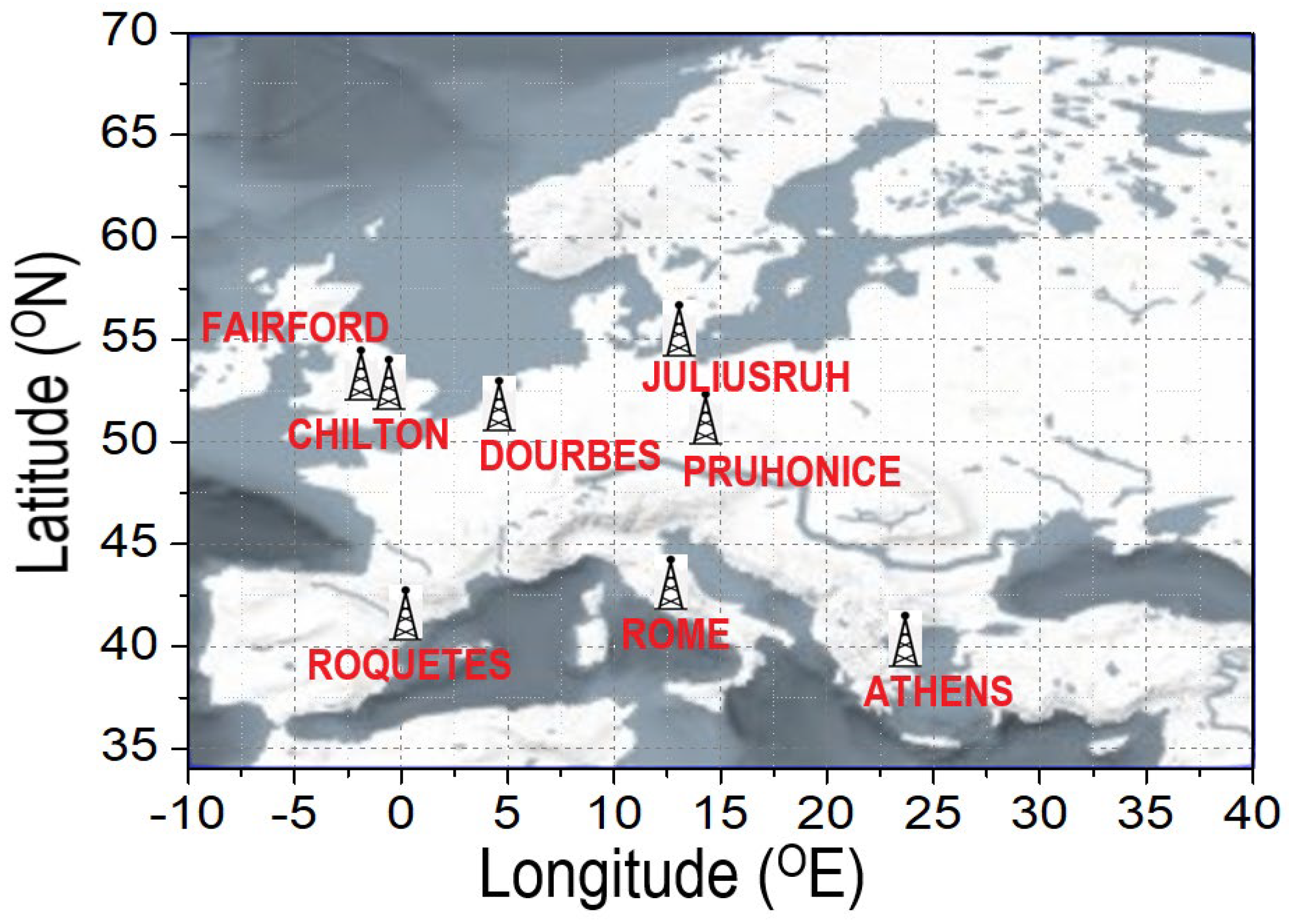
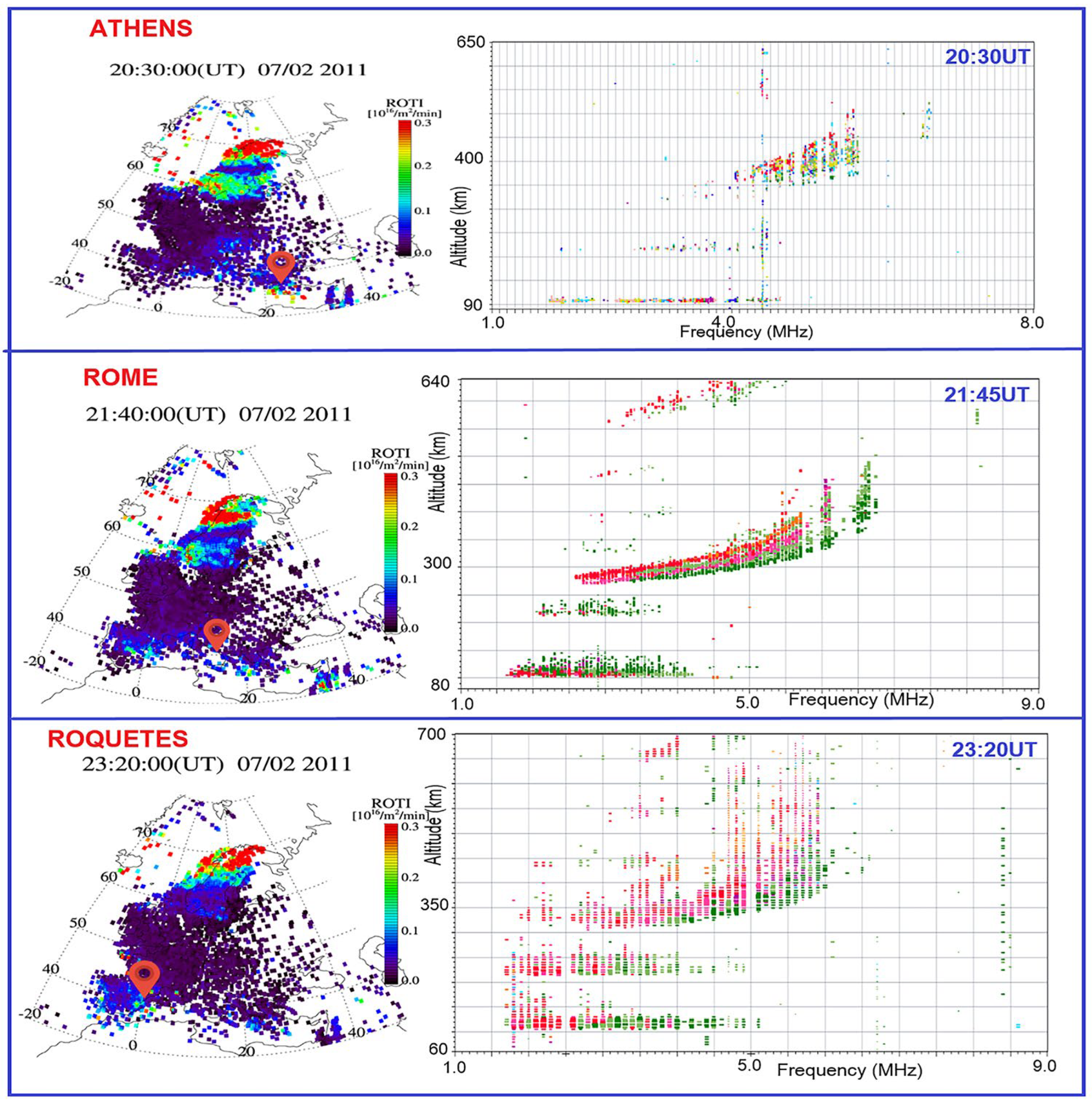
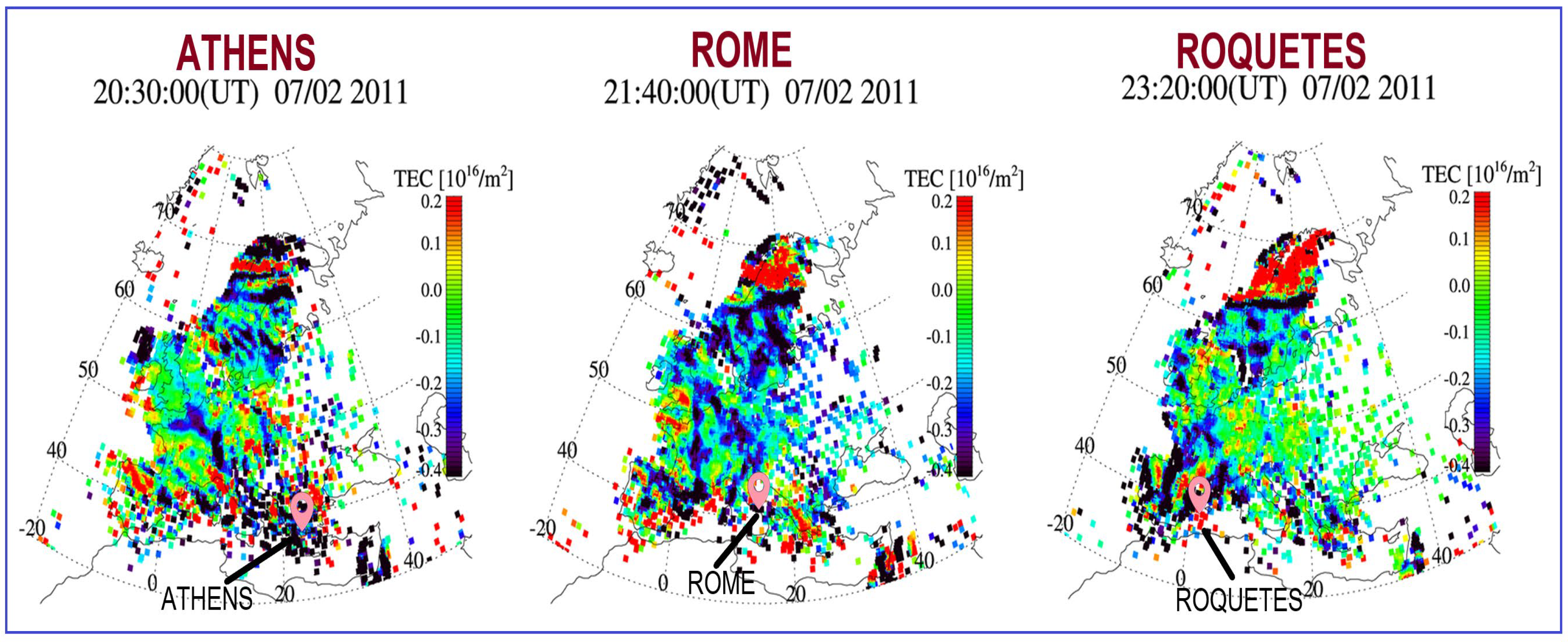
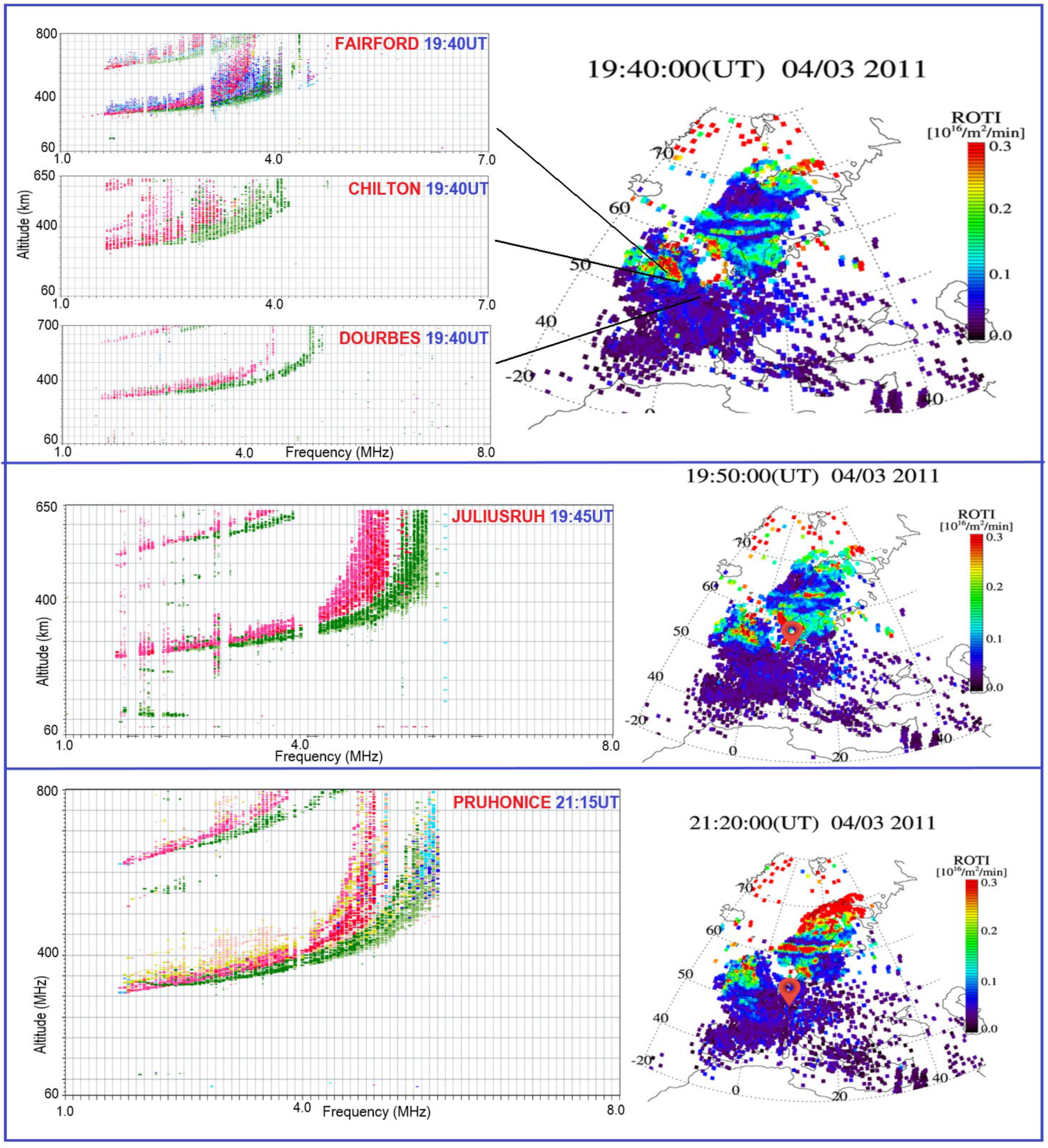
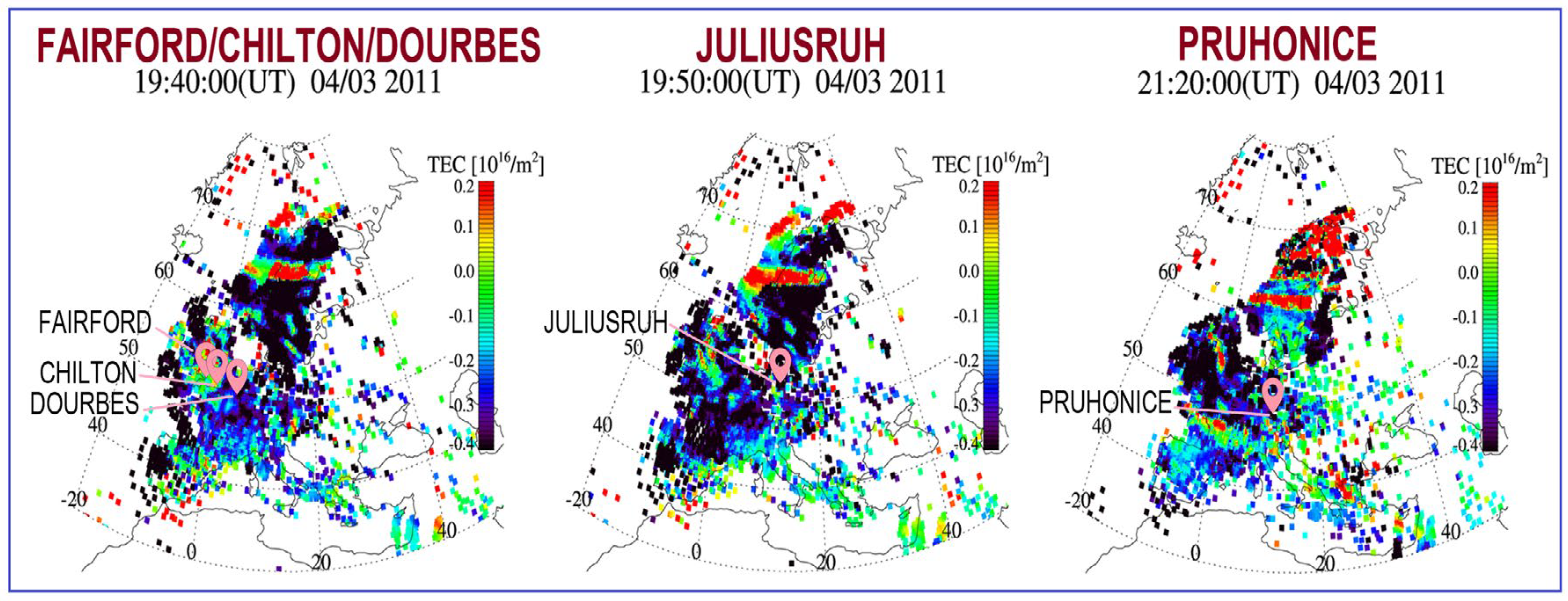
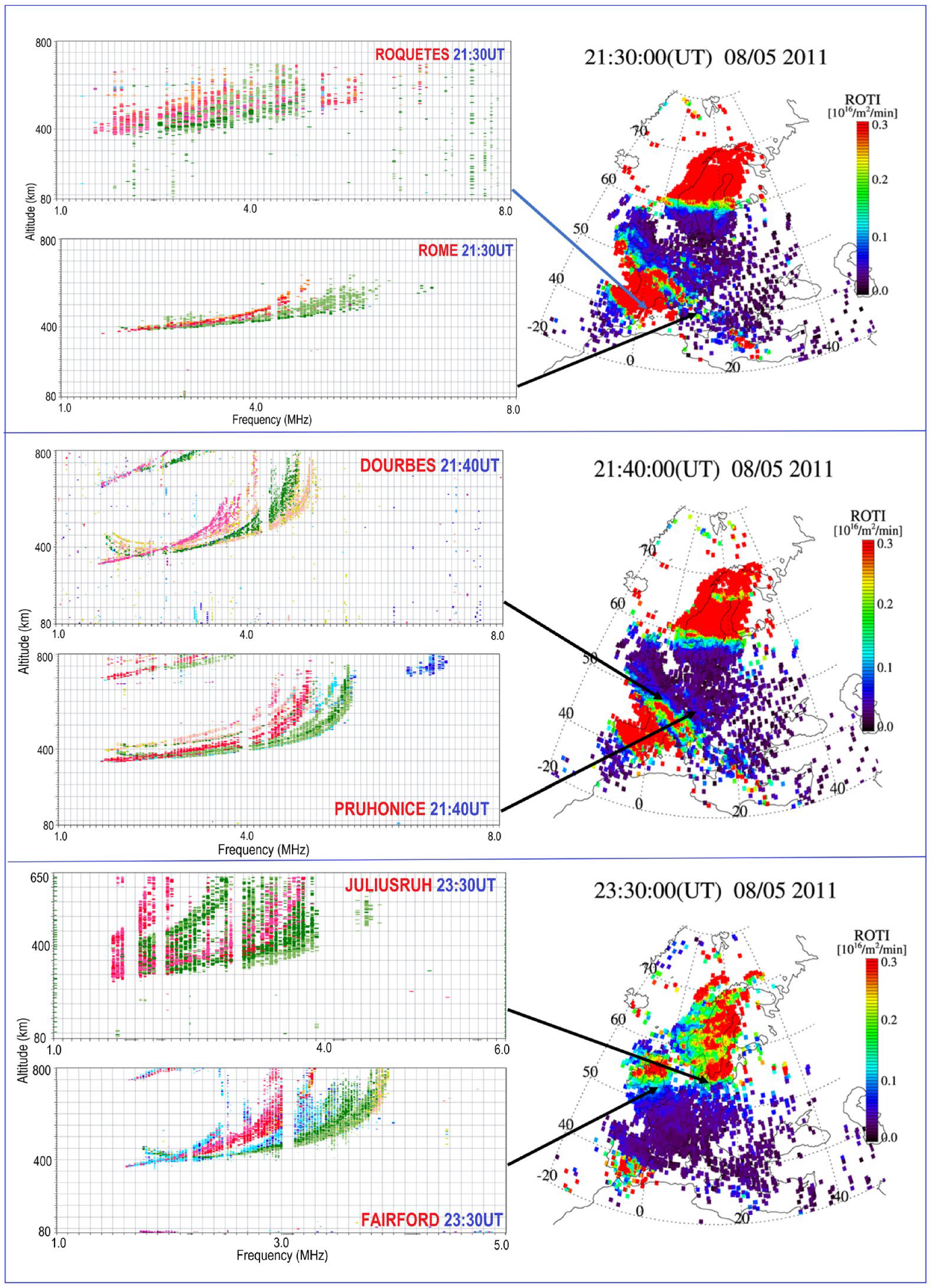
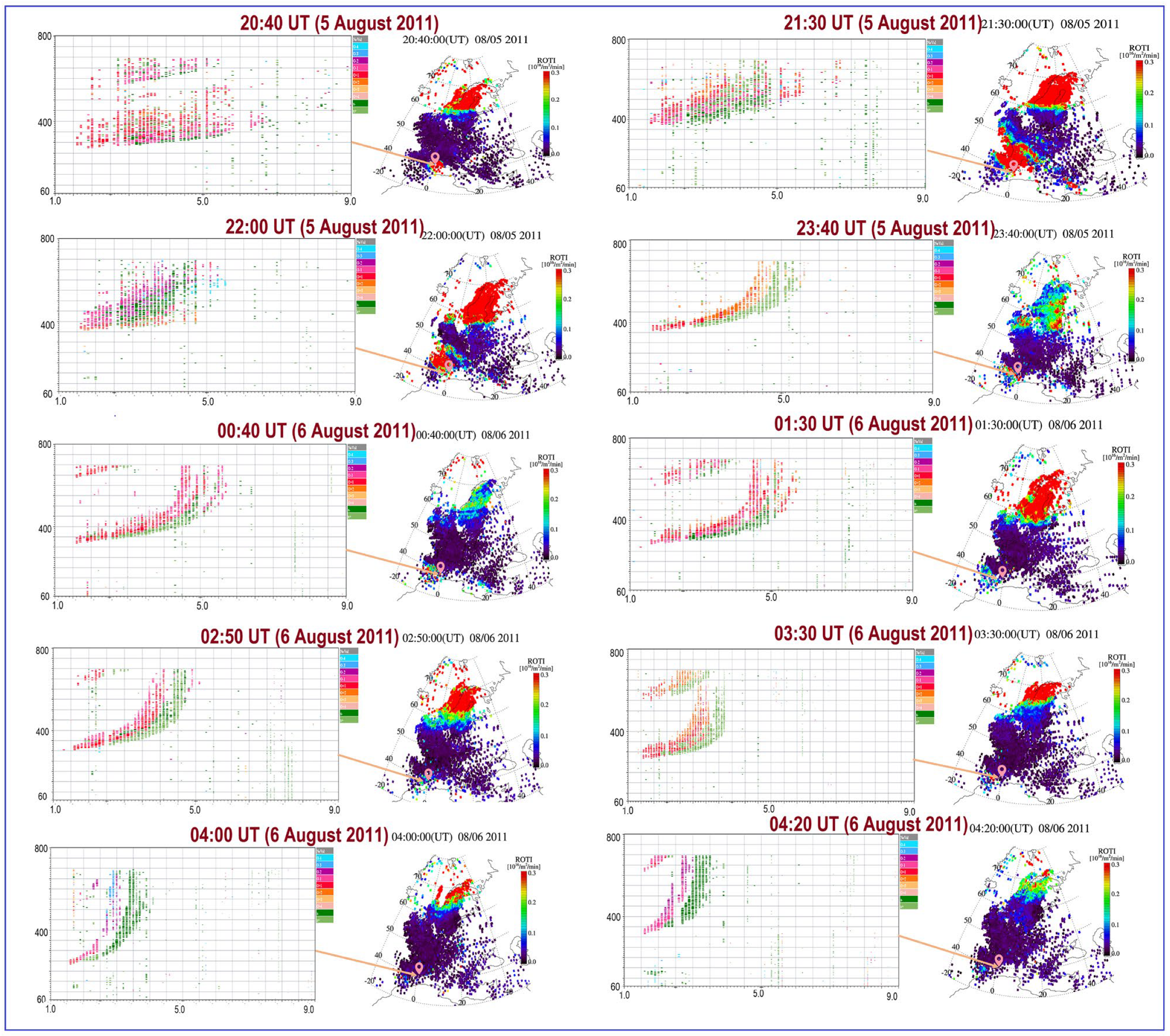
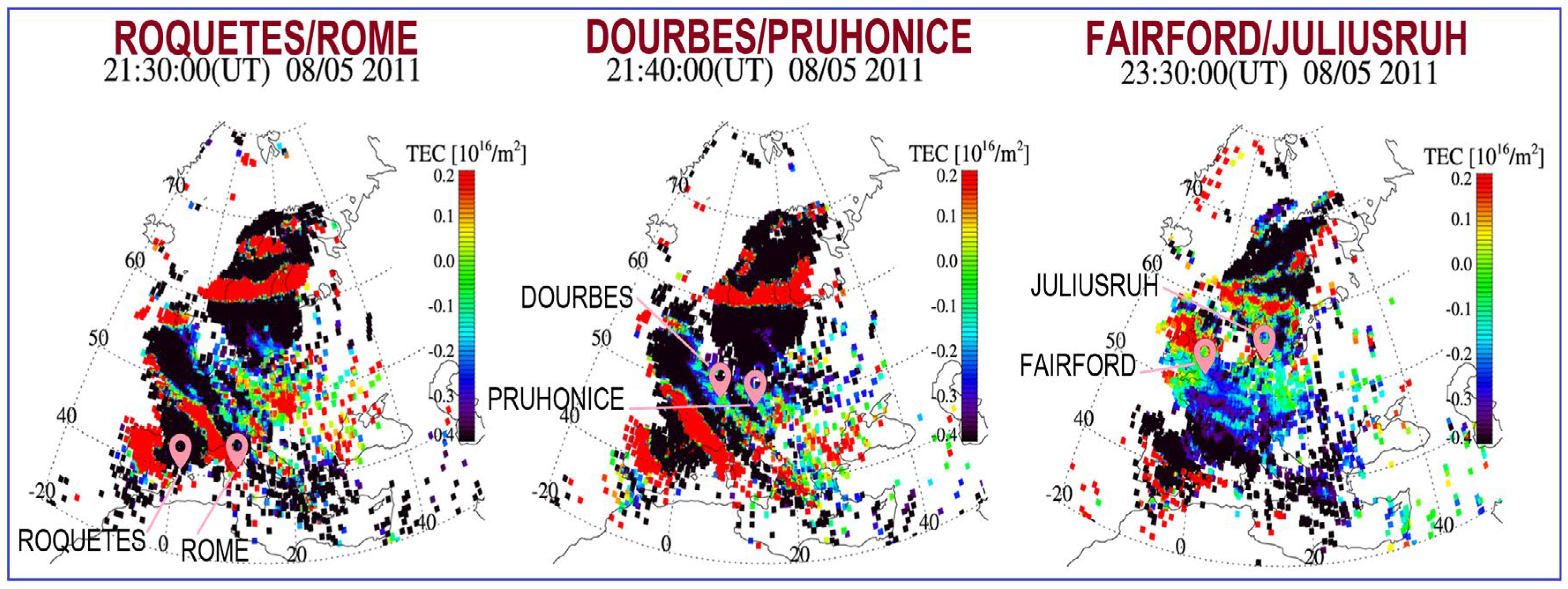
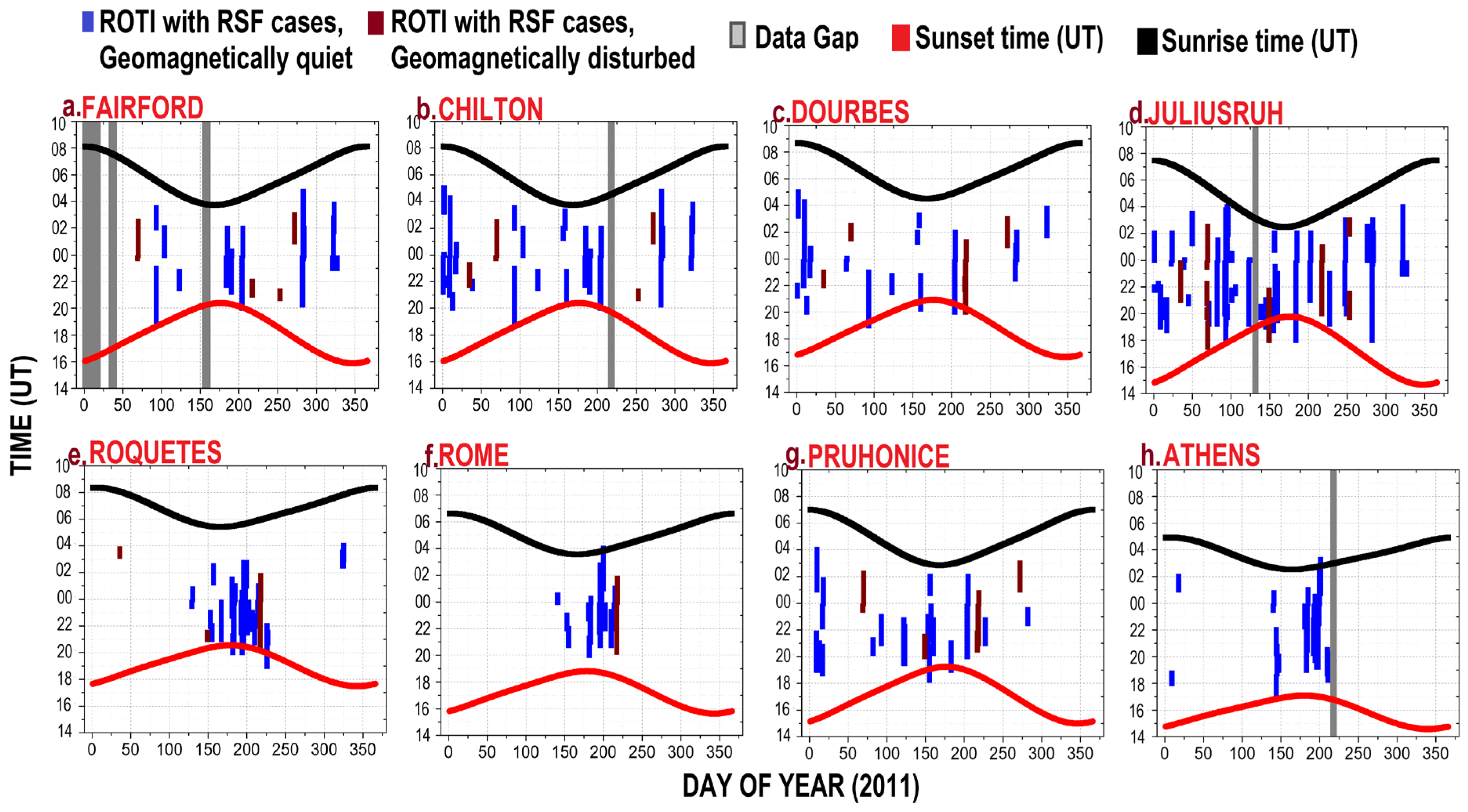

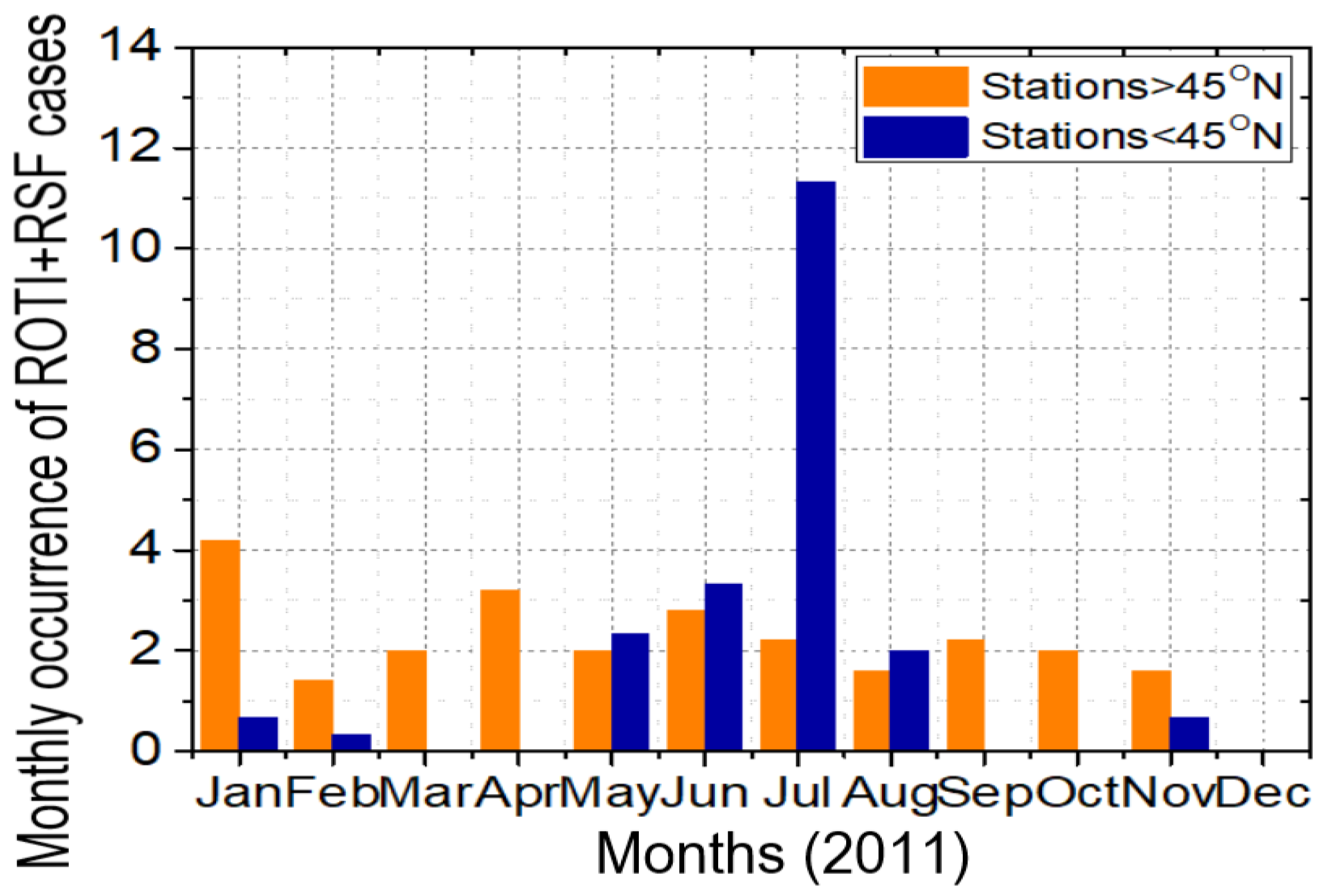
| Station Name | Station Code | Geographical Latitude (°N) | Geographical Longitude (°E) | Sampling Interval |
|---|---|---|---|---|
| Juliusruh | JR055 | 54.6 | 13.4 | 15 min. |
| Fairford | FF051 | 51.7 | 358.5 | 15 min. |
| Chilton | RL052 | 51.5 | 359.4 | 10 min. |
| Dourbes | DB049 | 50.1 | 4.6 | 5 min. |
| Pruhonice | PQ052 | 50 | 14.6 | 15 min. |
| Rome | RO041 | 41.9 | 12.5 | 15 min. |
| Roquetes | EB040 | 40.8 | 0.5 | 15 min. |
| Athens | AT138 | 38 | 23.5 | 15 min. |
Disclaimer/Publisher’s Note: The statements, opinions and data contained in all publications are solely those of the individual author(s) and contributor(s) and not of MDPI and/or the editor(s). MDPI and/or the editor(s) disclaim responsibility for any injury to people or property resulting from any ideas, methods, instructions or products referred to in the content. |
© 2024 by the authors. Licensee MDPI, Basel, Switzerland. This article is an open access article distributed under the terms and conditions of the Creative Commons Attribution (CC BY) license (https://creativecommons.org/licenses/by/4.0/).
Share and Cite
Paul, K.S.; Rafi, M.H.; Haralambous, H.; Mostafa, M.G. Correlation of Rate of TEC Index and Spread F over European Ionosondes. Atmosphere 2024, 15, 331. https://doi.org/10.3390/atmos15030331
Paul KS, Rafi MH, Haralambous H, Mostafa MG. Correlation of Rate of TEC Index and Spread F over European Ionosondes. Atmosphere. 2024; 15(3):331. https://doi.org/10.3390/atmos15030331
Chicago/Turabian StylePaul, Krishnendu Sekhar, Mehdi Hasan Rafi, Haris Haralambous, and Mohammad Golam Mostafa. 2024. "Correlation of Rate of TEC Index and Spread F over European Ionosondes" Atmosphere 15, no. 3: 331. https://doi.org/10.3390/atmos15030331
APA StylePaul, K. S., Rafi, M. H., Haralambous, H., & Mostafa, M. G. (2024). Correlation of Rate of TEC Index and Spread F over European Ionosondes. Atmosphere, 15(3), 331. https://doi.org/10.3390/atmos15030331







